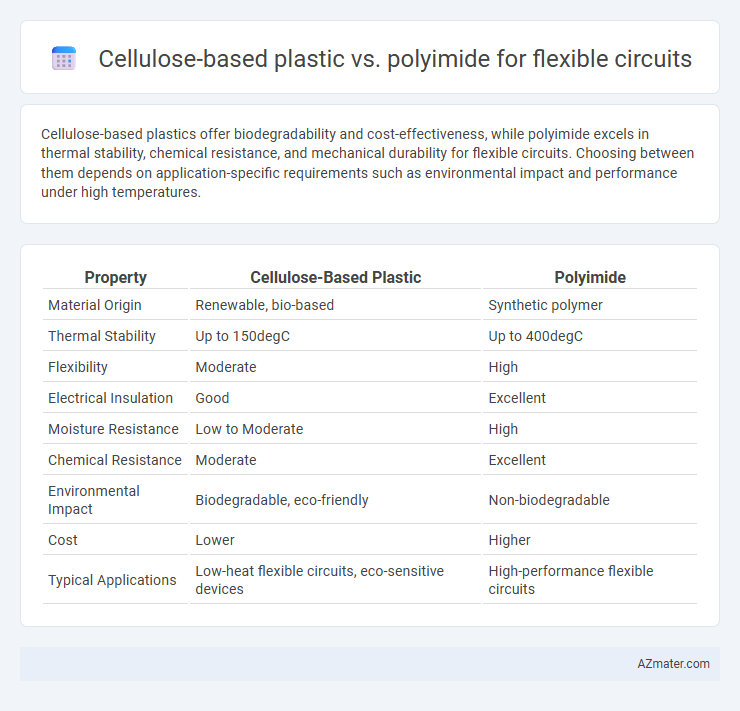Cellulose-based plastics offer biodegradability and cost-effectiveness, while polyimide excels in thermal stability, chemical resistance, and mechanical durability for flexible circuits. Choosing between them depends on application-specific requirements such as environmental impact and performance under high temperatures.
Table of Comparison
| Property | Cellulose-Based Plastic | Polyimide |
|---|---|---|
| Material Origin | Renewable, bio-based | Synthetic polymer |
| Thermal Stability | Up to 150degC | Up to 400degC |
| Flexibility | Moderate | High |
| Electrical Insulation | Good | Excellent |
| Moisture Resistance | Low to Moderate | High |
| Chemical Resistance | Moderate | Excellent |
| Environmental Impact | Biodegradable, eco-friendly | Non-biodegradable |
| Cost | Lower | Higher |
| Typical Applications | Low-heat flexible circuits, eco-sensitive devices | High-performance flexible circuits |
Introduction to Flexible Circuit Materials
Cellulose-based plastics offer biodegradable and renewable options with moderate thermal stability, making them suitable for eco-friendly flexible circuit substrates. Polyimide, a high-performance polymer, provides exceptional thermal resistance, mechanical strength, and electrical insulation, widely adopted in advanced flexible electronics. Selecting between cellulose-based plastics and polyimide depends on application requirements involving durability, temperature tolerance, and environmental impact.
Overview of Cellulose-Based Plastics
Cellulose-based plastics offer a sustainable and biodegradable alternative to traditional polymers used in flexible circuits, characterized by their natural origin from plant fibers such as wood pulp or cotton. These materials exhibit excellent mechanical flexibility, thermal stability up to around 200degC, and good dielectric properties, making them suitable for eco-friendly flexible electronic applications. Unlike polyimide, cellulose-based plastics provide enhanced biodegradability and reduced environmental impact, though they may have limitations in chemical resistance and long-term durability under harsh conditions.
Insights into Polyimide in Electronics
Polyimide is highly valued in flexible circuits for its exceptional thermal stability and dielectric properties, enabling reliable performance in high-temperature electronic applications. Its chemical resistance and mechanical flexibility outperform cellulose-based plastics, making polyimide ideal for complex, compact circuit designs. Superior electrical insulation and long-term durability solidify polyimide's role as a preferred substrate in advanced flexible electronics.
Mechanical Properties: Strength and Flexibility Comparison
Cellulose-based plastics exhibit moderate tensile strength and excellent flexibility due to their natural polymer chains, making them suitable for lightweight, bendable flexible circuits. Polyimide demonstrates superior mechanical strength and thermal stability, maintaining high flexibility but with enhanced durability under mechanical stress and repeated bending cycles. While cellulose-based plastics offer eco-friendly benefits, polyimide remains the preferred choice for high-performance flexible circuits requiring exceptional strength and long-term flexibility.
Thermal Stability: Performance Under Heat
Polyimide offers superior thermal stability compared to cellulose-based plastic, maintaining structural integrity and electrical performance at temperatures exceeding 300degC, which is critical for high-performance flexible circuits. Cellulose-based plastics typically degrade or lose flexibility at temperatures above 150degC, limiting their use in high-heat environments. The enhanced heat resistance of polyimide ensures reliable performance in automotive, aerospace, and industrial applications requiring prolonged exposure to elevated temperatures.
Electrical Insulation: Dielectric Properties
Cellulose-based plastics exhibit moderate dielectric constants around 3.5 to 4.5, offering sufficient electrical insulation for flexible circuits with low to moderate frequency applications, but their moisture absorption can impact long-term dielectric stability. Polyimide materials demonstrate superior dielectric properties, featuring low dielectric constants typically between 3.2 and 3.5 and high dielectric strength exceeding 300 kV/mm, ensuring excellent electrical insulation performance under varying environmental conditions. The enhanced thermal and chemical stability of polyimide makes it the preferred choice for advanced flexible circuits requiring reliable dielectric integrity in high-frequency and demanding operational environments.
Environmental Impact and Sustainability
Cellulose-based plastics offer significant environmental advantages over polyimide in flexible circuits due to their biodegradability and renewable origins, reducing long-term waste and reliance on fossil fuels. Polyimide, derived from petroleum-based sources, poses challenges in disposal and recycling, contributing to persistent environmental pollution and higher carbon footprints. Incorporating cellulose-based materials enhances sustainability by promoting circular economy practices and minimizing ecological impact throughout the flexible circuit lifecycle.
Manufacturability and Processing Techniques
Cellulose-based plastics offer biodegradable and cost-effective options for flexible circuit substrates, with ease of roll-to-roll processing and lower temperature curing compatible with sustainable manufacturing practices. Polyimide provides superior thermal stability, chemical resistance, and mechanical durability, supporting high-precision photolithography and etching essential for advanced flexible circuit applications. Manufacturing with polyimide requires more complex vacuum deposition and curing at elevated temperatures, which increases equipment and energy demands compared to cellulose-based alternatives.
Cost Analysis: Affordability and Scalability
Cellulose-based plastics offer a cost-effective alternative to polyimide in flexible circuit manufacturing, with raw materials sourced from renewable biomass reducing overall expenses. Polyimide, while providing superior thermal stability and electrical insulation, incurs higher production costs due to complex synthesis and processing requirements. Scalability favors cellulose-based plastics as bio-derived materials enable mass production with lower energy consumption and reduced environmental impact, making them more affordable for large-scale flexible circuit applications.
Future Trends and Industry Applications
Cellulose-based plastics are gaining traction in flexible circuits due to their biodegradability and renewable sourcing, aligning with sustainability trends in electronics manufacturing. Polyimide remains a dominant material for flexible circuits owing to its superior thermal stability, mechanical strength, and chemical resistance, essential for high-performance applications in aerospace and medical devices. Future industry applications are expected to increasingly integrate cellulose-based plastics for eco-friendly consumer electronics while leveraging polyimide in advanced, high-reliability sectors such as automotive and flexible displays.

Infographic: Cellulose-based plastic vs Polyimide for Flexible circuit
 azmater.com
azmater.com